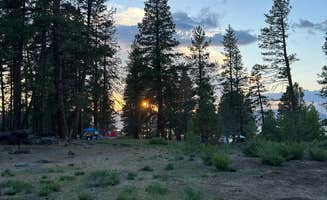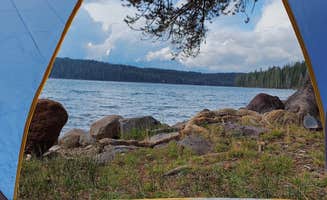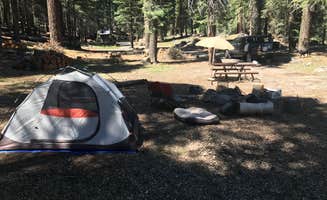Tent camping near Litchfield, California offers diverse experiences across the northeastern portion of Plumas National Forest, at elevations typically between 4,000-5,000 feet. The area features a mixed conifer forest ecosystem with seasonal changes affecting camping conditions dramatically—summer temperatures average in the 80s while fall nights can drop below freezing. Most dispersed camping sites require high-clearance vehicles to access the unimproved forest roads leading to established campgrounds.
What to do
Fishing at Eagle Lake: Camp at Aspen Grove Campground for easy lake access. "The sites were large and not too far from the parking lot, many were shaded with plenty of trees, and the lake was just a short walk away!" reports Lily H.
Hiking Osprey Overlook: Trails accessible from several campgrounds provide panoramic views. "I highly recommend hiking up to Osprey Overlook, not far from the campground. It has great panoramic views of the lake," shares a camper at Aspen Grove.
Creek exploration: Conklin Park Campgrounds sits beside a small creek. "We could hear the little creek and the wind through the burned trees. It was actually very peaceful!" notes Beck W., highlighting the post-fire forest recovery environment.
What campers like
Tent-only atmosphere: Aspen Grove Campground prohibits RVs, creating a unique camping experience. "The unique aspect of Aspen is it is set aside for Tent camping only. No RVs or cabovers are allowed here," explains Alison.
Simple facilities: Basic amenities at most sites maintain a rustic feel. At Crocker Campground, Jeannette H. found "a dry campground with scattered spots amongst the trees. It is quiet with a couple pit toilets."
Wildlife viewing: Many campsites offer opportunities to observe local fauna. "There is a beautiful meadow that goes for miles right next to the campground. Crocker Meadow," notes one camper, describing wildlife viewing opportunities.
What you should know
Road conditions: Many access roads require appropriate vehicles. At Laufman Campground, Dani P. warns "Road is gravel, one large pot hole in the middle of the road made it difficult for a compact or large RV to get into campground. Easy for a 4wd or high clearance rig."
Seasonal challenges: Services vary dramatically by season, with most facilities closing in winter. Laura M. notes her spring visit, "We stayed one night on the off season in April and it was free."
Site maintenance: Expect variable upkeep at less frequented locations. "Some of the sites were very overgrown. There were pit toilets that seemed like they hadn't been maintained but they were there nonetheless," reports Alex P.
Tips for camping with families
Water planning: No reliable drinking water exists at most sites. "No water or trash. During the season it runs $15/night plus $7 for additional vehicle," notes a camper at Laufman Campground.
Campsite selection: Find sites with natural barriers for child safety. At Rocky Point Dispersed Camping, Tom P. advises, "Large barren area with a toilet near the lake. Not great for a tent but can make it work. Good distance away from roads and houses."
Wildlife precautions: Store food properly in bear country. "There was one clean vault toilet at the site and a nice concrete picnic table and a container to keep your things safe from bears at each campsite," explains Beck W.
Tips from RVers
Turn-around space: Limited maneuvering room exists at many sites. At Rocky Point West, Jules S. cautions, "Road just ends so you have to turn around in grass/rock terrain if you go too far because there is no warning."
Site selection for larger vehicles: Look for specifically designated areas. "Small sites but big enough for RVs. Aspen filled Creek just a small walk south of campground," notes Dani P. when describing suitable locations.
Services lacking: Most tent camping areas near Litchfield lack hookups. "It's not worth $30 a night for pit toilets," reports one camper, explaining the value proposition when comparing established campgrounds with more rustic options.




